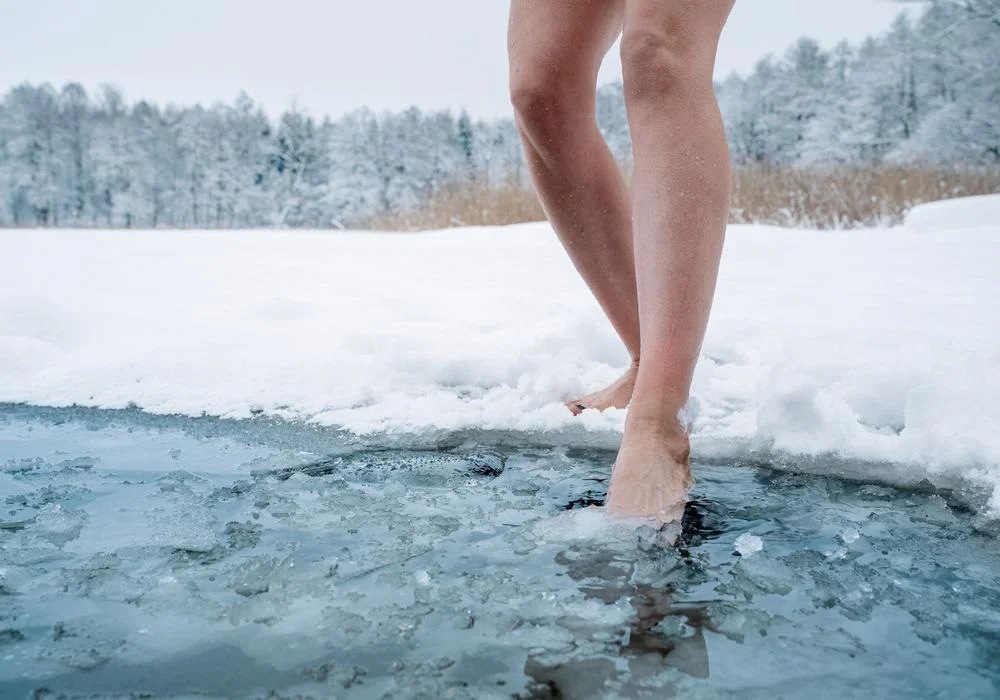Are you tired of tossing and turning, counting sheep, or staring at the ceiling all night? Insomnia can take a serious toll on your physical and mental health. But there’s a cool new approach that could help you find the rest you’ve been searching for in cold therapy. In this article, we’ll explore the science behind cold therapy, its benefits for insomnia sufferers, and how you can incorporate it into your bedtime routine for a more restful sleep. Say goodbye to sleepless nights and hello to a refreshed, rejuvenated you!
Contents
Does Cold Therapy Help Sleep?
Cold therapy can potentially help improve sleep for some individuals. The underlying concept is that cooling the body, particularly the brain, can help initiate and maintain sleep more effectively. Our body’s core temperature naturally drops during the night to facilitate sleep, and cold therapy aims to enhance this process.
Research on the subject is still limited. But there are some studies suggesting that cold therapy can improve sleep quality, especially in those with insomnia or sleep disturbances. However, it’s essential to note that individual responses to cold therapy may vary, and what works for one person may not work for another. It is always a good idea to consult with a healthcare professional before trying any new sleep-related therapies.
What Is The Science Behind Cold Therapy and Sleep Regulation?
The science behind cold therapy and sleep regulation is primarily based on the relationship between body temperature and sleep. The body’s core temperature follows a circadian rhythm. Which is a 24-hour cycle that regulates various physiological processes, including sleep. Here’s a closer look at how cold therapy might influence sleep regulation:
- Thermoregulation and sleep onset
As bedtime approaches, the body’s core temperature naturally decreases, signaling the brain to release melatonin, a hormone that promotes sleepiness. A cooler environment or body temperature can potentially enhance this process, making it easier for individuals to fall asleep.
- Slow-wave sleep and body temperature
Slow-wave sleep, also known as deep sleep, is a crucial stage of the sleep cycle during which the body undergoes restorative processes. Research has shown that cooler body temperatures can promote more extended periods of slow-wave sleep. That results in better sleep quality and overall rest.
- Brain temperature
The temperature of the brain can also impact sleep quality. Some studies have suggested that cooling the prefrontal cortex, the part of the brain associated with executive functions and decision-making, can help reduce sleep latency (the time it takes to fall asleep) and improve sleep quality.
- Insomnia and body temperature
People with insomnia often have difficulty falling asleep, staying asleep, or both. Research has shown that they tend to have a higher core body temperature at night. That interferes with their ability to initiate and maintain sleep. Cold therapy aims to lower the body temperature, potentially alleviating insomnia symptoms.
While there is evidence to support the relationship between cold therapy and sleep regulation, more research is needed to establish a definitive link. And also, understand the optimal methods and conditions for applying cold therapy. It’s essential to consult with a healthcare professional before trying cold therapy or any other new sleep-related intervention.
What Are The Techniques Of Cold Therapy For Insomnia Relief?
 There are several cold therapy techniques that can be used for insomnia relief. These methods aim to lower body temperature, promote relaxation, and improve sleep quality. Here are some techniques to consider:
There are several cold therapy techniques that can be used for insomnia relief. These methods aim to lower body temperature, promote relaxation, and improve sleep quality. Here are some techniques to consider:
- Cool your bedroom: Maintain a cool bedroom environment, ideally between 60-67°F (15-19°C), to help facilitate sleep. You can use an air conditioner, or fan, or open a window to achieve the desired temperature.
- Cold shower or bath: Taking a cold shower or bath before bedtime can help lower your body temperature and signal your body that it’s time to sleep. If a cold shower is too uncomfortable, try a lukewarm one instead.
- Cooling pillows and bedding: Use cooling pillows, mattress pads, or bed sheets made from breathable, moisture-wicking materials like cotton, bamboo, or performance fabrics designed to keep you cool during sleep.
- Cold foot bath: Soaking your feet in a basin filled with cold or cool water for 10-15 minutes before bed can help lower your body temperature and promote relaxation.
- Wear lightweight, breathable sleepwear: Choose loose-fitting, lightweight sleepwear made from breathable materials like cotton or bamboo. That can help regulate your body temperature during sleep.
- Hydrate: Staying properly hydrated can help regulate body temperature. Drink enough water throughout the day and consider having a glass of cool water before bedtime.
Remember that individual responses to cold therapy may vary. And what works for one person may not work for another. It’s essential to consult with a healthcare professional before trying any new sleep-related therapies. Experiment with different techniques to find the ones that work best for you.
Where Do You Put Ice To Sleep?
While using ice to help with sleep might not be a common practice, the concept of applying cold to specific areas of the body to promote relaxation and sleep is based on the principles of cold therapy. If you’re interested in trying a cold therapy technique, here are some suggestions:
- Forehead or temples: You can apply a cold pack, ice pack, or a cold cloth to your forehead or temples. This can help cool the prefrontal cortex, which may promote relaxation and sleep.
- Wrists or neck: Applying a cold pack or ice wrapped in a thin cloth to your wrists or the back of your neck can help cool your blood vessels close to the skin’s surface. This may help lower your overall body temperature, making it easier to fall asleep.
- Feet: If you have hot or restless feet, you can try placing a cold pack or ice pack wrapped in a thin cloth on the soles of your feet or under your ankles. This can help cool down your body temperature and promote relaxation.
Remember that when using ice or cold packs, always wrap them in a thin cloth or towel to prevent frostbite or skin irritation. It’s essential to monitor your skin for any adverse reactions and discontinue use if discomfort occurs.
Keep in mind that individual responses to cold therapy may vary. If you’re considering using cold therapy to help with sleep, it’s always a good idea to consult with a healthcare professional for personalized advice.
Safety Precautions For Effective Cold Therapy For Insomnia
 When using cold therapy for insomnia relief, it’s essential to follow safety precautions to avoid any adverse effects or injuries. Here are some safety tips for effective cold therapy:
When using cold therapy for insomnia relief, it’s essential to follow safety precautions to avoid any adverse effects or injuries. Here are some safety tips for effective cold therapy:
- Gradual exposure
Start with mild cold therapy techniques and gradually increase the intensity as you become more comfortable. For example, begin with a lukewarm shower before progressing to a cold one, or use a cool pack instead of an ice pack initially.
- Protect your skin
Always wrap ice or cold packs in a thin cloth or towel to prevent frostbite or skin irritation. Check your skin regularly for any signs of redness, numbness, or discomfort, and discontinue use if any adverse reactions occur.
- Time limits
Limit the duration of direct cold application to 15-20 minutes at a time. Prolonged exposure to cold can lead to frostbite, nerve damage, or other injuries.
- Monitor your body’s response
Pay attention to how your body reacts to cold therapy. If you feel too cold, shivering, or experience discomfort, stop the therapy and warm up gradually. Listen to your body and adjust the techniques accordingly.
- Combine with other sleep strategies
Cold therapy may be more effective when combined with other sleep-promoting strategies, such as maintaining a consistent sleep schedule, practicing relaxation techniques, and creating a sleep-friendly environment.
- Be cautious with certain conditions
Individuals with certain medical conditions, such as Raynaud’s disease, poor circulation, or nerve damage, should be cautious when using cold therapy and consult with a healthcare professional before trying these techniques.
By following these safety precautions, you can ensure that your cold therapy experience is both effective and safe, potentially leading to improved sleep quality and insomnia relief.
Is It Okay To Put Ice Every Night?
Using ice every night may not be suitable for everyone, as it can cause skin irritation or frostbite if not used correctly. If you choose to use ice as part of a cold therapy routine to help with sleep, always wrap it in a thin cloth or towel. And make sure to limit the application duration to 15-20 minutes.
It’s essential to listen to your body and consult a healthcare professional for personalized advice before trying any new sleep-related interventions. However, make sure that you are not putting ice on more than once a day. As this can increase the risk of skin irritation, frostbite, or other potential injuries due to overexposure to cold temperatures.
Conclusion
In conclusion, cold therapy presents a promising approach to alleviating insomnia and improving sleep quality for many individuals. By exploring various techniques and adhering to safety precautions, you can potentially find the right cold therapy method that works best for you. Always consult with a healthcare professional before trying new sleep-related interventions and consider combining cold therapy with other sleep-promoting strategies for optimal results. Embrace the power of cold therapy, and you may find yourself enjoying more restful, rejuvenating sleep night after night.
For more information, please contact MantraCare. Relationships are an essential part of human life. It is the connection between people, and it helps us to form social bonds, and understand and empathize with others. If you have any queries regarding Online Relationship Counseling experienced therapists at MantraCare can help: Book a trial therapy session


